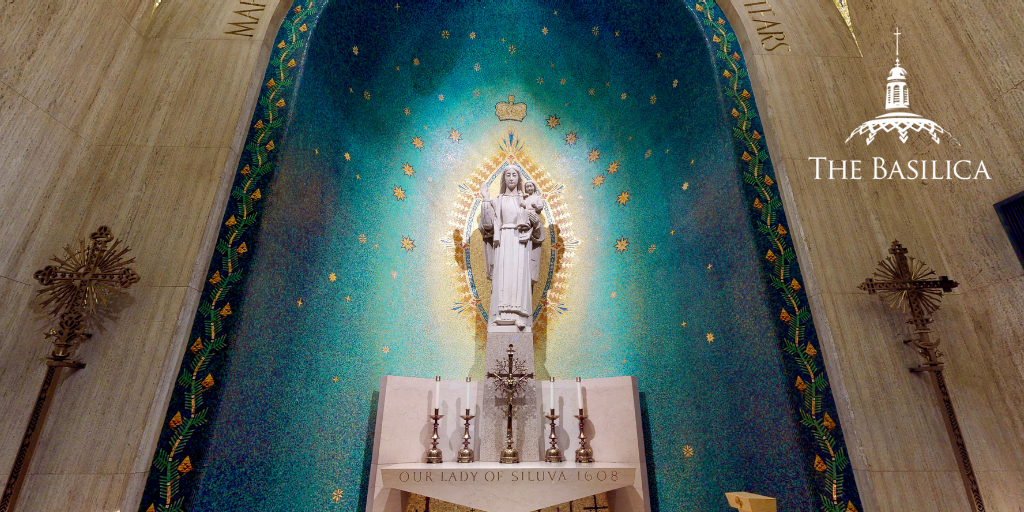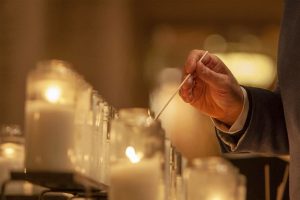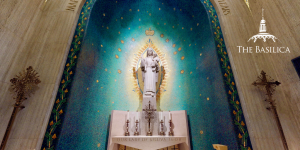
With more than 80 chapels and oratories honoring Mary, the Basilica is proud to represent the peoples, cultures, and traditions that are the fabric of the Catholic faith. Whether through mosaic, stone sculpture, or vivid stained glass, the art and architecture of America’s Catholic Church provide a kaleidoscope of the many manifestations of the Blessed Mother from across the globe.
In this new series on the blog, we invite you to take a virtual tour of the most distinctive places Mary is honored in sculpture at the Basilica – from the beloved Our Lady of Lourdes Chapel to the reflective Our Mother of Sorrows Chapel. Today’s post focuses on sculptures honoring devotions of Marian protection, featuring immersive 360° tour images from throughout the halls of America’s Catholic Church.
Our Lady of Mount Carmel
According to tradition, the scapular of Carmel was presented to St. Simon Stock in the 13th century during a period when the Carmelite Order was severely oppressed. The scapular has become a widely used devotion, with special significance for protection as well as serving as a reminder to practice the “habit” of Christian conduct, as described by St. Pope John Paul II.
Gifted to the Basilica by the Carmelite Fathers of the American Provinces, the Chapel of Our Lady of Mount Carmel was dedicated in 1965. At the center of the chapel’s mosaic, Our Lady of Mount Carmel is depicted in relief: the Mother and Child hold the brown scapular given to Simon Stock on May 16, 1251, and are encircled by sculptures of six Carmelite saints.
Our Lady of La Vang
Our Lady of La Vang is a Vietnamese Marian tradition which originated in the 18th century. As the lower classes pushed back against the Catholic presence in the country, Christians fled to the remote jungle region of La Vang. Though under duress, the faithful would gather each night to pray the rosary under a large tree. Tradition holds that on one of those nights during praying the Rosary, Mary appeared to them with the infant Jesus and presented a fern to treat their illnesses. She brought encouragement and promised that their prayers would be heard. As the persecution continued, she appeared multiple times in the same location.
In the Chapel of Our Lady of La Vang on the Lower Level of the Basilica, a glass mosaic depicts the faithful of La Vang in period dress as they encounter Mary. Across the chapel, a twin mosaic is a copy of the painting “The Martyrs of Vietnam.” Overhead stretches a dark blue ceiling dotted with 24 stars to represent the night sky, and at the front of the chapel stands a statue of Our Lady carved in a unique multi-marble style by Italian artist Giancarlo Buratti.
Mary, Queen of Ireland
The Mary, Queen of Ireland Oratory honors the Blessed Mother’s provision in the Emerald Isle. It features a statue of Our Lady and the Holy Child upon a hexagonal rock formation, which is representative of the Giant’s Causeway, the basalt columns that jut out of the sea along the north coast of Northern Ireland. The alabaster window depicts themes of Irish devotion to the Blessed Mother and pilgrimage: the Shrine of Our Lady of Knock; the Mass Rock, which refers to Masses celebrated in secret in violation of the Penal Codes; the Crough or “mountain” of Patrick, where the saint fasted for 40 days and nights; and the Legion of Mary, founded in 1921 in Dublin for the Catholic laity.
Our Lady of Siluva
In 1457, a nobleman named Petras Gedgaudas built a church in Šiluva in honor of the feast of the Nativity of the Blessed Mary, bringing an icon from Rome for the church. It became a place of pilgrimage for many, with crowds of the faithful from all over the country and neighboring Prussia coming to celebrate the Nativity of Mary. However, when the church was forced to close in 1569 due to government opposition, the parish priest buried the icon along with important church documents in an iron box on the church property to keep them safe. For the next 39 years, the icon remained hidden under the earth, until it was rediscovered with the help of a group of shepherd children. Although the original chapel had perished in a fire during that time, the faithful of Šiluva built a new chapel on the property to house the icon, and soon began welcoming pilgrims to honor Our Lady once more.
Dedicated on September 4, 1966, the chapel to Our Lady of Šiluva at the Basilica features a Trani marble statue of Our Lady and the Infant Jesus in native dress, created by Lithuanian sculptor Vytautas Kašuba. Pinecones and boughs, a symbol of Šiluva, are also found throughout the chapel, while the altar frontal depicts the Hill of Crosses. Mosaics reminiscent of the fabric art of Lithuania line the side walls of the chapel, displaying images of Saint Casimir and the sufferings of the Lithuanian people, relating them to the sufferings of Christ.
Source:
“Honor Mary, Lithuanian Style,” National Catholic Register
Rohling, Geraldine M., PhD, MAEd. The Basilica of the National Shrine of the Immaculate Conception: Guide and Tour Book. Washington, D.C.: Basilica of the National Shrine of the Immaculate Conception, 2018.
Light a Candle at the Basilica
 In honor of Our Lady, we invite you to light a candle today at the National Shrine. Vigil candles burn in the chapels throughout the Great Upper Church and lower crypt level of the National Shrine. Each candle represents the faith of the supplicants and their fervent prayers entrusted to the loving intercession of the Blessed Mother.
In honor of Our Lady, we invite you to light a candle today at the National Shrine. Vigil candles burn in the chapels throughout the Great Upper Church and lower crypt level of the National Shrine. Each candle represents the faith of the supplicants and their fervent prayers entrusted to the loving intercession of the Blessed Mother.

